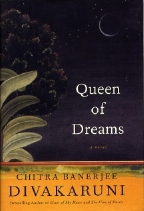Queen of Dreams
Doubleday / Random House
US Hardback First Edition
ISBN: 0385506821
Publication Date: 09-14-2004
352 Pages; $21.95
Date Reviewed: 24th September 2004
Reviewed by: Serena Trowbridge © 2004
|
|
|
REFERENCES
|
COLUMNS
|
|
General
Fiction, Fantasy
|
News 08-26-04
|
This is a novel to haunt your dreams. Some novels catch at your
subconscious and leave you with a lingering awareness of the
mysteries of life, and there is no doubt in my mind that this is one
of them. This is Chitra Banerjee Divakaruni's fourth novel, following
bestsellers such as The Mistress of Spices and Sister of My Heart, as
well as short fiction and poetry. It is a novel where the narrative
alternates between the understood and the mystical. In fact it seems
to me that Divakaruni is a secret purveyor of magic realism, where
the things we don't understand (such as dreams) can be at least
partially explained and made sense of through a kind of magic.
In many ways this novels falls (not neatly, but at least clearly)
into two halves. Firstly, and prosaically, the first part of the
novel concentrates on the lives and histories of the characters. Mrs
Gupta, the Queen of Dreams, tells the dreams of the local people,
interpreting their dreams and the effects on their lives. She is a
somewhat mysterious figure, even to her family, and who will not talk
about her past life in India, much to the disappointment of her
daughter, Rakhi. Rakhi is the central character of the novel, and all
her life she has dreamed of India and her mother's secret life of
dreams. American born, Rakhi is still coming to terms with the divide
in her family's history, between India and the US, and she runs an
ethnic-style coffee shop in Berkeley, California, with her friend
Belle (Balant), and also paints and exhibits. Recently divorced,
Rakhi will not discuss the reasons for her divorce, and fights with
her ex-husband, Sonny, for their small daughter, Jona. It is Rakhi's
search for meaning and truth that is at the heart of the novel.
The second half of the novel is where reality, dreams and
nightmares begin to intertwine and blur. After her mother's death,
Rakhi finds her dream journal, which she reads with the aid of her
father to translate the Bengali words in an attempt to interpret and
understand her mother's life, and thus make sense of her death. Rakhi
also finds herself struggling with her business, relationships, and
the devastating events of September 11, 2001.
The novel is also divided between India and the US, although set
entirely in America. To Rakhi, as no doubt to many US-born Indians,
India represents the mystical and the longed for - quite literally a
land of dreams, and one that she is on a quest to understand, through
the cryptic medium of her mother's dream journal. As she and her
friends and family try to come to terms with their lives and origins,
their peace of mind is totally shattered by events in the world
around them. India becomes little more than a myth in the shocked
aftermath of the terrorist attacks on the world they know and love,
and yet it is also the key to their past and present lives.
The continuity of the lives of women is a major feature of this
and other novels by Divakaruni. The worlds and understanding of men
and women are firmly separated, and the men play mostly peripheral
roles, only sometimes impinging on the horizon of the women's lives.
The concept of knowledge that is handed down from mother to daughter
is significant here, and female solidarity seems the only way to
survive. The conscious and unconscious bonds between mother and
daughter are also fully explored and central to the plot, both with
Rakhi and Mrs Gupta, and Jona and Rakhi. However the father as a
distant figure is also considered, and after her mother's death Rakhi
develops her relationship with her father, who to her delight will
tell her the stories of India that her mother wouldn't or
couldn't.
The novel is written in two contrasting styles: in the present
tense, the story of Rakhi's journey towards understanding is set out
with a sense of immediacy that enables the reader to travel with her.
You're quickly drawn into her world. By contrast, the dreams and the
Indian scenes -- the more mystical narratives -- are written in a
languid, glistening prose closer to poetry than novels usually
manage. They reflect the intense and magical subject matter, where
dreams "mix past and present, history and hope, truth and desire".
Chitra Banerjee Divakaruni specializes in vivid and luscious
descriptions. The reality of the world today breaks in as a bit of a
shock - just like life, which is one of many reasons that this novel
is a fascinating read.
